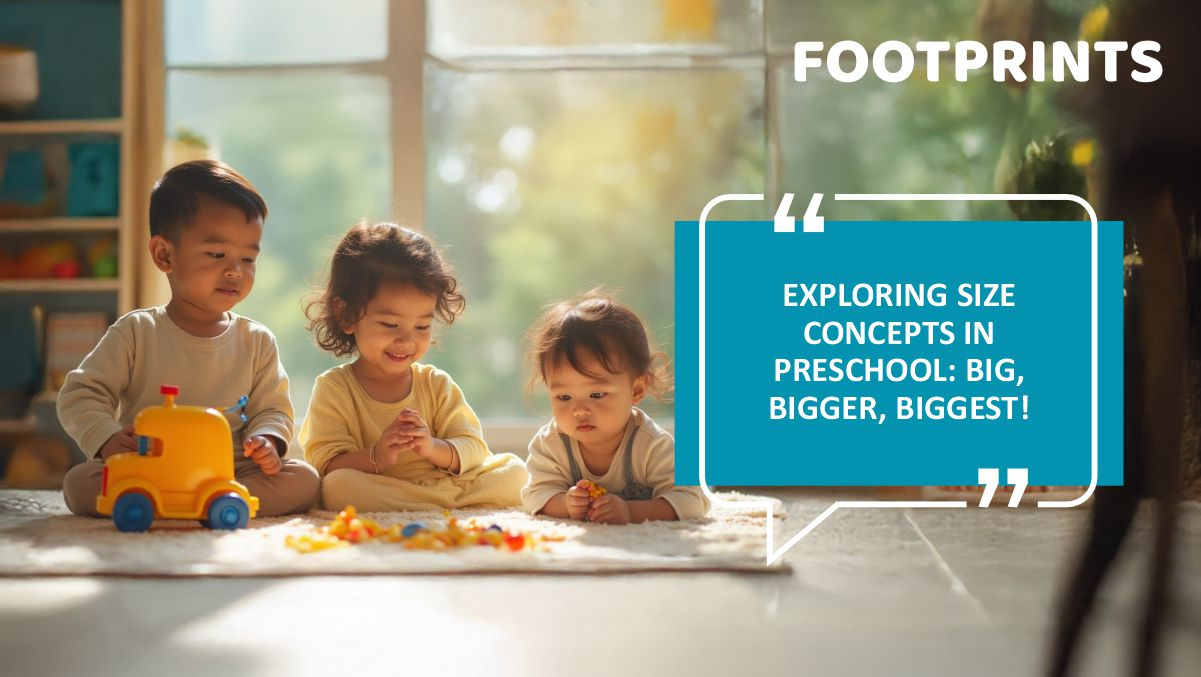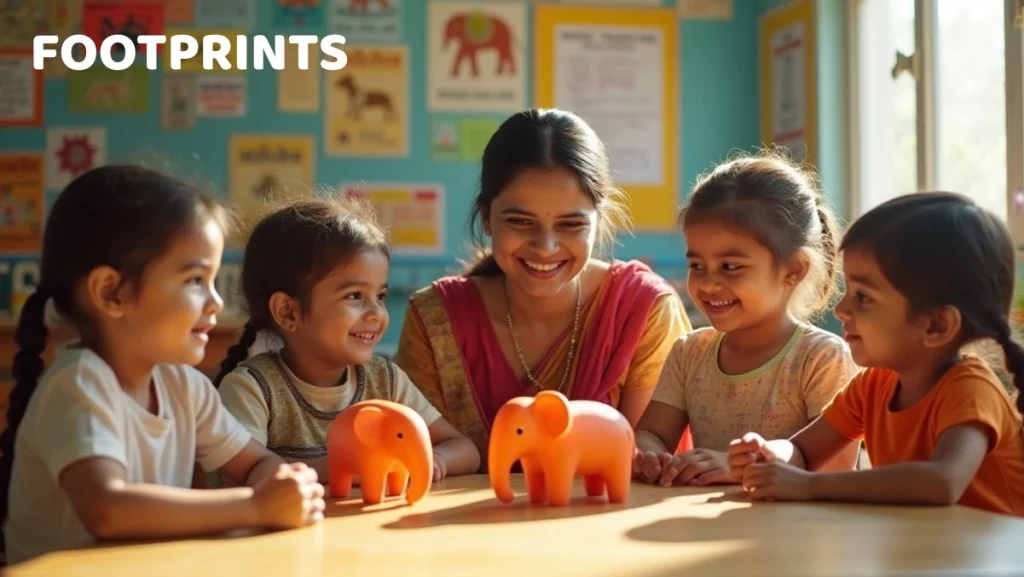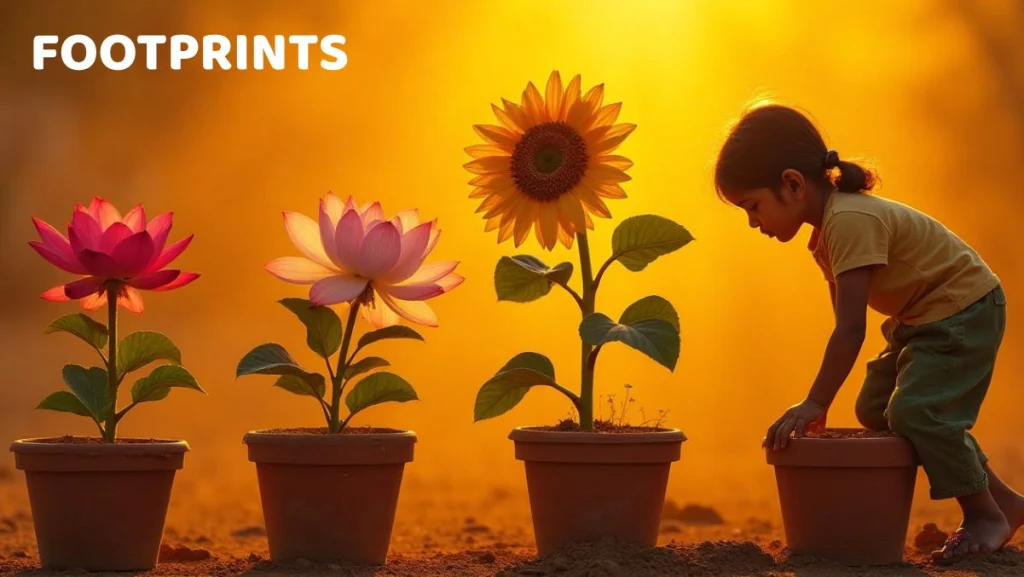

At the foundational stages of development, preschoolers start to put the world in order through comparison. Size is one of the first and most accessible comparisons that they make. Therefore, through this blog, we introduce the ideas of big, bigger, and biggest to children, which in turn introduces early math concepts, language growth, and observational skills. This article looks at what educators and parents can do to introduce the concepts of big and small at preschools or playschools. Also, we will see how institutions like Footprints Childcare implement learning via real-life applications and interactive activities. In what ways does size play a critical role in early childhood education? Size comparison is a first step in the development of Basic Math Concepts, which include measurement, sorting, and sequencing. We put forth that by teaching the concept of big and small for kindergarten children to see and describe sizes, big, bigger, and biggest, we are, in fact, putting forward skills that are the basis for math, science, and communication.
Developmental Benefits: Aspects of Development Essential for Continuous Growth
• Enhances problem-solving skills
• Builds descriptive vocabulary
• Encourages comparative thinking
In environments such as Footprints Preschool, these skills are incorporated into the day’s routine, play, and exploration which in turn causes children to absorb the concepts naturally. Which is Greater? How preschoolers learn to compare. Which of these two options do you prefer?
Activity Example: Present some toy trucks and cars.
Ask the child: Which one can cover more distance? Let the child respond in the way that is best for them. This visual and tactile approach we use at Footprints Childcare also proves to be an effective method. We begin in the classroom with items like bags, books, or boxes, and have the children compare these with their peers.
Big, Bigger, Biggest: A list of large things children love. As you introduce the concepts of big, bigger, and biggest to your children, you are not only teaching them words, but you are helping them grasp the idea of various levels of intensities. This is a visual sequence that children can see, and play out with their toys, in nature, and in the everyday world around them.
A Classic Big, Bigger, Biggest Example:
• A small teddy bear (big)
• A medium teddy bear (bigger)
• A giant teddy bear (the biggest)

Tips for Teaching the Sequence:
Use everyday items (cups, shoes, lunchboxes). In everyday life, notice the size differences (Like that one time yuu might have seen the largest tree on a street). In Footprints Preschool, we present size progression through songs, games, and interactive storytelling, which in turn makes the concept fun for the children. While distinguishing between Big and Largest, in some cases, what we see is the difference between the biggest and the largest.
Simple Preschool-Friendly Explanation: Big is a term that children use for size, whereas largest is a term which may refer to quantity, area, or volume, and is more technical. For example, the greatest in size may not also be the greatest in weight or volume. For preschoolers it’s better to use a big, bigger, biggest example, which is easier to see and say.
Big big big! The Power of Repetition. In songs, chants, and books, we use big words, which in turn is a great way to build vocabulary. At Footprints Childcare, we use music and rhythm to also play with concepts of size and other descriptions. Example Chant: Big bigger biggest, look and you will see! A little mouse, a fluffy cat, a lion free and wild! Footmarks and Size Perception in Play-Based Learning. At Footprints Preschool, we have size integrated into all of our activities.
How Footprints Enhance Size Learning
• Outdoor play: Children compare trees in terms of size, also they look at leaves, and play structures.
• Storytime: Books that include Goldilocks and the Three Bears are used to discuss this.
• Art and construction: Children use different-sized blocks to see which tower they can build the highest. Hands-On Activities to Teach Size Concepts
According to theory, children learn best. Here are some practices for teaching the idea of big and small, which will work well in the preschool class.
1. Size Breakdown Table. Give children everyday things like spoons, shoes, balls to put in the small, medium, and large groups.
2. Nature’s Great Search Out. Ask children to find the
- The biggest leaf
- The bigger rock
- The smallest twig
3. Create a book of sizes. Big, bigger, biggest.
4. Building Task. Use bricks to build a tower. Then ask, “Can you make it bigger?” And ask what is bigger?
Can you build the tallest tower in our class?

Preschool Size Questions: When children ask regarding size, here’s what they often want to know and how we can answer them-
Question: Which is larger, an elephant or a house?
Answer: A home is of greater size, but the elephant is the largest land animal.
Question: Can what be heavy that is small?
Answer: Of course! Little things at times may have great weight.
Using what we know from research and practice, which is that when we present concepts in a very clear and practical way, we are also at the same time supporting the development of critical thinking and the acquisition of new vocabulary out which will in turn support future math and science studies.
Extending the Learning
Building out area experts is what we do with related concepts. As to your lessons on size, we present a larger picture:
Math: Present Basic Math Concepts related to counting and size. Ask children to use non-standard units for measuring (blocks or hands).
Art: Let children put together collages which include large, larger, largest cut outs from magazines.
Cognitive: Use sorting and classification puzzles based on size. Science: Science Studies:. Observe animal prints and compare sizes (also great for combining nature and biology). Summary
Size comparison allows preschoolers to explore and put into words their world. Through play, stories, and routine interaction,s the concepts of large, larger, and largest are incorporated into their everyday life.
Key Takeaways: Focus on visual, tactile comparisons
Use everyday items in a fun way. Reinforce language through the use of repetition and storytelling.
Conclusion
A Giant Step in Primary Education, size is more than identifying what is large or small, it’s also about learning to see, compare, and describe. At Footprints Preschool, we foster these early skills in a setting that is growth-oriented. Through that early foundation that we lay, children step out into the next stage of learning armed with the tools to sort, compare, and measure the world around them.
Aditya brings over ten years of expertise as a Senior Marketing Strategist. He’s an expert at developing captivating marketing tactics that regularly provide excellent outcomes. His innovative strategies have demonstrated a track record of increasing organizational reach and engagement, showcasing his extensive knowledge of the contemporary marketing landscape.

